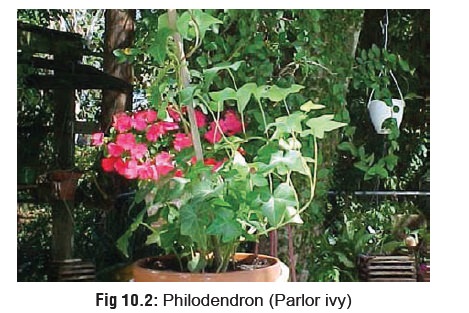Chapter: Modern Medical Toxicology: Organic Poisons (Toxins): Irritant Plants
Oropharyngeal Irritant Plants

Oropharyngeal Irritant Plants
Dumbcane
Other Common Names
Dumbplant;
Mother-in-law’s tongue; Tuftroot.
Botanical Name
Dieffenbachia species.
Physical Appearance
This plant belonging to family Araceae can grow up to 6 feet, and has a fleshy, waxy stem with large, smooth leaves that are generally green on the periphery and mottled white in the center (Fig 10.1).

Uses
It
is a popular ornamental houseplant. While most houseplants are non-toxic (Table 10.1), dumbcane is among the few
exceptions.


Toxic Part
All
parts, especially leaves.
Toxic Principle
Calcium
oxalate crystals.
Mode of Action
■■ The leaves and stem contain high amounts of insolublecalcium oxalate in the form of needle-like crystals packaged in raphides and bundled into elongated idioblasts. The idio-blasts are cigar shaped structures with specialised nozzles at each end, capable of firing the needle-like raphides in the form of projectiles when force is applied (e.g. chewing). Thus when a leaf is bitten into, thousands of idioblasts fire the needle-like calcium oxalate crystals which penetrate mucous membranes and deposit proteolytic enzymes. The latter stimulate a cascade of events leading to release of bradykinin and histamine.
![]()
■■ Studies on Dieffenbachia picta in guinea pigs
demonstrated the most toxic part of the plant was the stem juice, which, when
dropped into the mouths of the animals, caused lip and tongue oedema, nasal
secretions and progressive respiratory difficulties.
Clinical Features
·
Most cases of dumbcane poisoning
involve oral exposure causing immediate and severe symptoms of pain and local
swelling. Patients often describe the intense agony as akin to chewing powdered
glass. There is severe swelling of the lips, mouth, and tongue, with
salivation. There may be interference with swallowing and breathing. Oral
paraes-thesia, with severe pain and numbness in the perioral area may occur.
·
Ocular exposure to expressed sap may
cause immediate pain, lacrimation, photophobia, corneal abrasions, and
deposition of calcium oxalate crystals on the corneal epithe-lium.
·
Systemic toxicity due to calcium
oxalate is rare. Bloody emesis and diarrhoea may occur. Vomiting may be
profuse. Following large ingestions, oxalic acid is formed in the stomach and
subsequently absorbed into the systemic circulation. There it binds with
calcium, and may cause hypocalcaemia. This could lead to weak, irregular pulse,
bradycardia, hypotension, and cardiac dysrhythmias.
Treatment
1.
In patients with severe poisoning,
examine the urine for calcium oxalate crystals. Also, monitor calcium and renal
function (BUN, creatinine).
2.
Local treatment with cold milk or
ice cream as a demulcent is sufficient in most cases. Cold water or sucking on
crushed ice will also relieve oral pain. Remove all visible evidence of plant
debris from the oropharynx.
3.
In severe cases, parenteral opioids,
corticosteroids, IV fluids, and endotracheal intubation may be required. Tetany
should be treated with intravenous calcium gluconate.
4.
Ocular exposure to sap resulting in
chemical conjuncti-vitis and corneal abrasions must be treated with copious
irrigation, systemic analgesics, and expert ophthalmologic consultation.
Philodendron
There
are over 200 species of Philodendron. They are epiphytic herbs, primarily with
climbing stems. They rarely stand erect. Identification is difficult because of
the many different sizes and shapes of the leaves.
![]()
Other Common Names
Panda
plant; Parlor ivy.
Botanical Name
Philodendron.
Physical Appearance
Small plant with variously shaped, glossy,
dark green leaves (Fig 10.2).

Uses
Popular
houseplant.
Toxic Part
Leaves,
stem.
Mode of Action
·
This plant contains calcium oxalate
crystals, and causes GI irritation and local swelling. The raphides are
contained in ampoule-like cells that, when ruptured by chewing or crushing,
eject their contents into tissue. It appears that the rupturing of these cells,
and the injection of the cell contents occurs at the same time.
Crystallographic evidence indicatesthat there is some free oxalic acid in the
cells.
·
The raphides may also be coated with
various proteolytic enzymes which produce additional tissue damage.
Clinical Features
1.
Mild GI distress: Dysphagia, nausea,
vomiting, oral pain, and perioral swelling may occur. Stomatitis, swelling of
the tongue, and excessive salivation may be seen after ingestion.
2.
Hypocalcaemia and tetany are
unlikely unless large amount has been ingested.
3.
Cutaneous exposure results in
delayed contact dermatitis in sensitised individuals, due to the presence of
resorcinol (an alkyl agent). Allergic contact dermatitis has been reported in a
number of cases.
Usual Fatal Dose
Philodendrons may have as much as 0.7% oxalates. As little as 5 grams may be fatal. This would represent over 700 grams of leaves.
Treatment
·
General measures:
o Dilution
with milk or water may be of benefit by washing out the crystals and assisting
in decontamina-tion of the oral pharynx.
o Cold
water or ice pack application may relieve local pain in the mouth.
·
Analgesics may be required if the
pain is intense.
·
If large amounts have been ingested,
the urine may be examined for oxalate crystals, but so far, crystals have not
been reported after philodendron ingestion.
·
Corticosteroid dressings have been
recommended for treat-ment of allergic dermatitis.
Related Topics